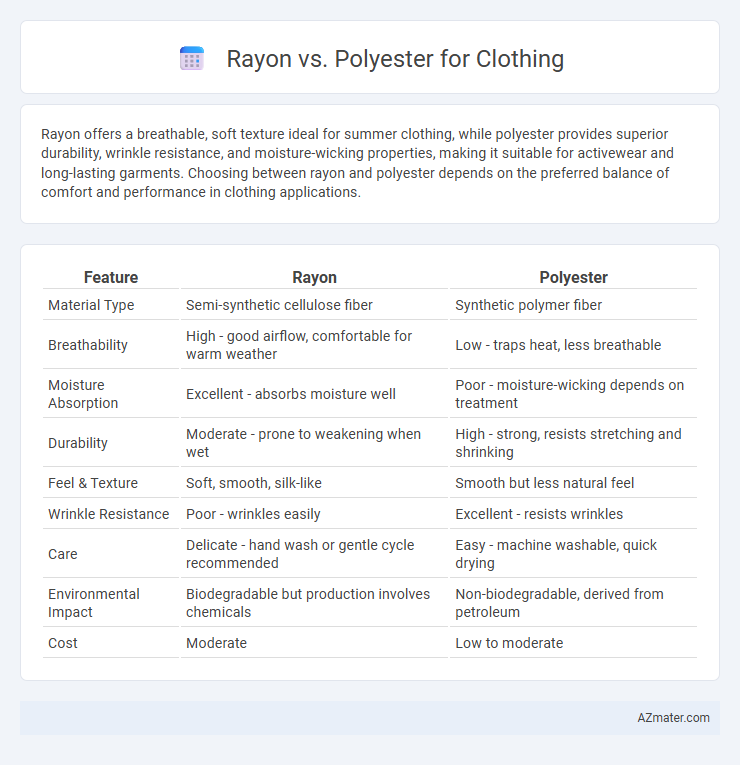Rayon offers a breathable, soft texture ideal for summer clothing, while polyester provides superior durability, wrinkle resistance, and moisture-wicking properties, making it suitable for activewear and long-lasting garments. Choosing between rayon and polyester depends on the preferred balance of comfort and performance in clothing applications.
Table of Comparison
| Feature | Rayon | Polyester |
|---|---|---|
| Material Type | Semi-synthetic cellulose fiber | Synthetic polymer fiber |
| Breathability | High - good airflow, comfortable for warm weather | Low - traps heat, less breathable |
| Moisture Absorption | Excellent - absorbs moisture well | Poor - moisture-wicking depends on treatment |
| Durability | Moderate - prone to weakening when wet | High - strong, resists stretching and shrinking |
| Feel & Texture | Soft, smooth, silk-like | Smooth but less natural feel |
| Wrinkle Resistance | Poor - wrinkles easily | Excellent - resists wrinkles |
| Care | Delicate - hand wash or gentle cycle recommended | Easy - machine washable, quick drying |
| Environmental Impact | Biodegradable but production involves chemicals | Non-biodegradable, derived from petroleum |
| Cost | Moderate | Low to moderate |
Introduction: Comparing Rayon and Polyester
Rayon, a semi-synthetic fiber derived from cellulose, offers a soft, breathable fabric often favored for its natural feel and moisture absorption. Polyester, a fully synthetic polymer made from petrochemicals, is renowned for durability, wrinkle resistance, and quick-drying properties. Comparing these textiles reveals key differences in comfort, maintenance, and environmental impact, guiding optimal clothing choices.
What is Rayon?
Rayon is a semi-synthetic fiber made from regenerated cellulose derived from wood pulp, offering a silky texture and excellent breathability. It is highly absorbent, making it ideal for warm-weather clothing and moisture-wicking applications. Unlike fully synthetic fibers like polyester, rayon provides a softer feel and better drape, closely mimicking natural fibers such as cotton or silk.
What is Polyester?
Polyester is a synthetic fiber derived from petroleum-based polymers, widely used in clothing due to its durability, resistance to wrinkles, and moisture-wicking properties. This fabric offers high tensile strength, making it ideal for activewear, outdoor gear, and everyday apparel. Polyester's ability to retain shape and resist shrinking enhances garment longevity compared to natural fibers.
Comfort and Feel: Rayon vs Polyester
Rayon offers a soft, breathable, and lightweight feel, making it ideal for warm weather and providing superior comfort compared to polyester. Polyester is more durable and wrinkle-resistant but tends to trap heat and can feel less breathable, often resulting in a less comfortable wear for extended periods. The choice between rayon and polyester significantly impacts clothing comfort, especially in terms of moisture absorption and breathability.
Breathability and Moisture-Wicking
Rayon offers superior breathability compared to polyester, making it ideal for warm weather clothing by allowing better air circulation. Polyester excels in moisture-wicking properties, efficiently drawing sweat away from the skin to keep wearers dry during intense physical activity. Combining rayon's airflow benefits with polyester's moisture management creates fabrics that enhance comfort and performance.
Durability and Longevity
Rayon, a semi-synthetic fiber derived from cellulose, tends to be less durable than polyester, as it weakens when wet and is prone to stretching and shrinking over time. Polyester, a fully synthetic polymer, offers superior durability and longevity due to its resistance to abrasion, shrinking, and wrinkles, making it ideal for garments requiring long-lasting wear. Fabrics made from polyester maintain their shape and color better than rayon, contributing to extended garment lifespan in everyday use.
Care and Maintenance
Rayon clothing requires gentle care, often needing hand washing or dry cleaning to maintain fabric integrity and prevent shrinking or stretching. Polyester is more durable and wrinkle-resistant, allowing machine washing and drying without significant damage or color fading. Both fabrics benefit from air drying and low-heat ironing to extend garment lifespan and preserve appearance.
Sustainability and Environmental Impact
Rayon, derived from natural cellulose fibers like wood pulp, is biodegradable but often involves chemical-intensive production processes that can harm ecosystems if not managed responsibly. Polyester, a synthetic fiber made from petroleum, has a higher carbon footprint and is non-biodegradable but can be recycled to reduce environmental impact. Sustainable clothing choices depend on factors like sourcing transparency, production practices, and end-of-life recyclability of either fiber.
Best Uses for Rayon and Polyester Clothing
Rayon excels in breathable, lightweight clothing ideal for warm weather, such as summer dresses, blouses, and linings, due to its moisture-absorbing properties and soft texture. Polyester stands out for activewear, outerwear, and wrinkle-resistant garments because of its durability, quick-drying nature, and resistance to stretching and shrinking. Choosing between rayon and polyester depends on the desired garment function: comfort and breathability favor rayon, while longevity and easy care favor polyester.
Conclusion: Which Fabric is Better for You?
Rayon offers a soft, breathable, and eco-friendly option ideal for warm climates and sensitive skin, while polyester excels in durability, moisture-wicking, and wrinkle resistance suitable for activewear and low-maintenance garments. Choosing between rayon and polyester depends on your priorities: comfort and natural feel versus longevity and easy care. For sustainable fashion with a natural touch, rayon is better; for high-performance and budget-friendly clothing, polyester remains the optimal choice.

Infographic: Rayon vs Polyester for Clothing
 azmater.com
azmater.com